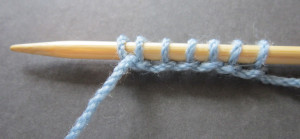After you’ve completed stringing beads onto your yarn for Irish Coffee Cozy, its time to cast on. You won’t be using beads for a while, so slide them down along the yarn out of the way until needed later when knitting the beaded design.
In the previous KAL Kick-off article, I promised 2 different methods for casting on that are well-suited to seaming a strip of garter stitch end-to-end using without the complexity of a provisional cast on.
The part that simple half-hitch cast on plays in seaming
Sometimes it’s the simple things in knitting often forgotten that work the best. Using the simple half-hitch cast on might be one of those. The path the yarn takes around the needle leaves just a single strand of yarn beneath of the loops of the cast on edge.
The simple half-hitch cast on is made by forming a backwards loop of the yarn on your thumb, then inserting needle tip through the loop (sometimes referred to as a simple cast on, or one-tailed cast on, or the thumb method of casting on). You can also review this previous Knit HeartStrings article – Simple Cast On :: a time and place for simplicity.
The simple half-hitch cast on is what I usually recommend for beaded garter stitch that will be joined into a tube. Whether the seam will be sewn or knit together later, this produces minimal bulk that is basically invisible on the right side.
The simple half-hitch cast on + sewn seam was what we used for last year’s Beading Hearts Friendship Bracelet.
Don’t like to sew? You’ll be happy to see that the pattern instructions for Irish Coffee Cozy substitutes a no-sew 3-needle bind off method that again starts with a simple half-hitch cast on for minimalist seaming.
As a bonus, I will also talk later in the KAL about how the simple half-hitch cast on can be used in place of doing a provisional cast on. You will be able to use this for invisibly seaming with Kitchener garter stitch for those who want to learn that.
After you have cast on 18 stitches, you are ready to start knitting at row 1 of the design.
Adapting beaded garter stitch designs to start with long tail cast on
It is also possible to use the familiar 2-ended long tail cast on to begin the Cozy, but with one important difference.
For long tail cast on, one end of the yarn knits on a row of stitches, and the other end acts like the simple half-hitch cast on.
So after you have cast on 18 stitches with the long tail method, DO NOT work row 1. Instead, start knitting at row 2 of the design.
Note: Since the long tail cast on effectively works the first row of the design, if the design had called for beading on that first row, you would need to work the beads into your cast on.
That is why I usually recommend the simple half-hitch cast on for beaded garter stitch rather than long tail (or other methods). Even if there is beading on the first row of the design, you would just knit that first beaded row normally.
Since the beaded garter design for this project has a plain wrong side row at both the beginning and end of the chart, you can just do a regular long tail cast on without the extra complication of working in the beads at the same time. We could cover that in one of next year’s projects if you’d be interested?



 HeartStrings FiberArts
HeartStrings FiberArts Knitting Bits of Lace on Facebook
Knitting Bits of Lace on Facebook Ravelry Store
Ravelry Store